Known for its captivating sound and versatility, the French horn has become an integral part of various musical ensembles. From its warm and resonant tones to its ability to blend seamlessly with other instruments, the French horn adds depth and richness to orchestras, wind bands, and chamber groups.
In this article, we’ll dive into transposition for French horn. Whether you’re a passionate player or simply intrigued by this iconic instrument, get ready to level-up your skills and never play in wrong key again!
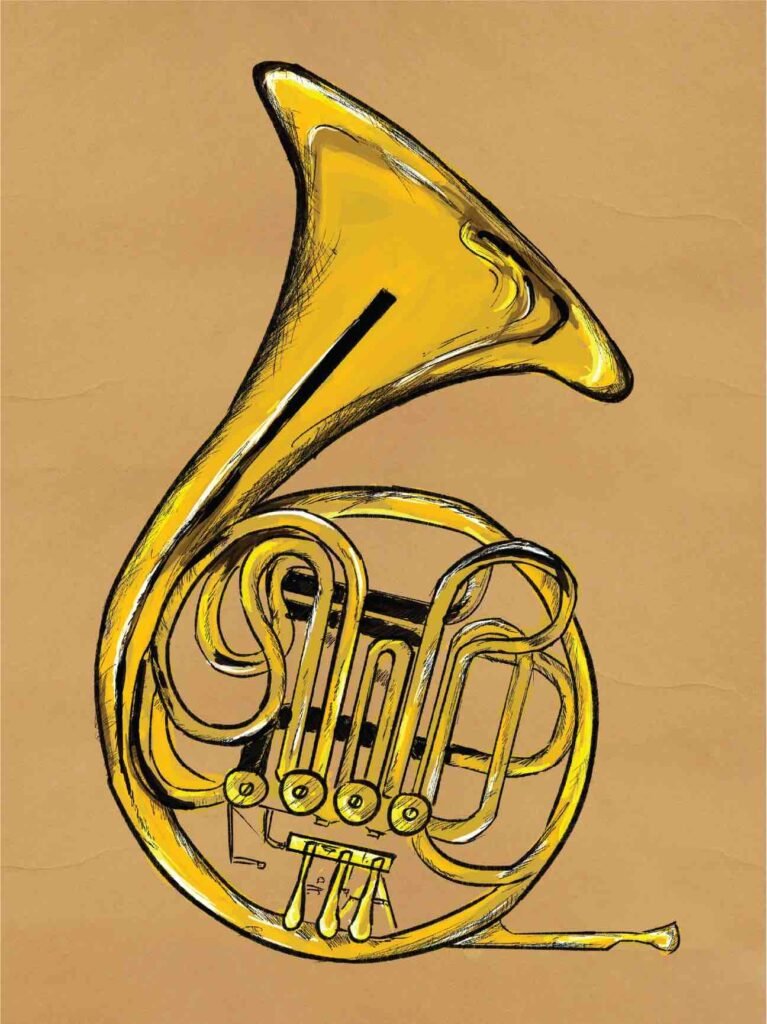
The French Horn in F
The French horn is a transposing instrument in the key of F. A transposing instrument meands the note we hear is different to the note the musician plays.
When the player reads a C on the staff and play a C, we hear the F natural below. In other words, the French Horn’s written pitch is a perfect 5th above its sounding pitch.
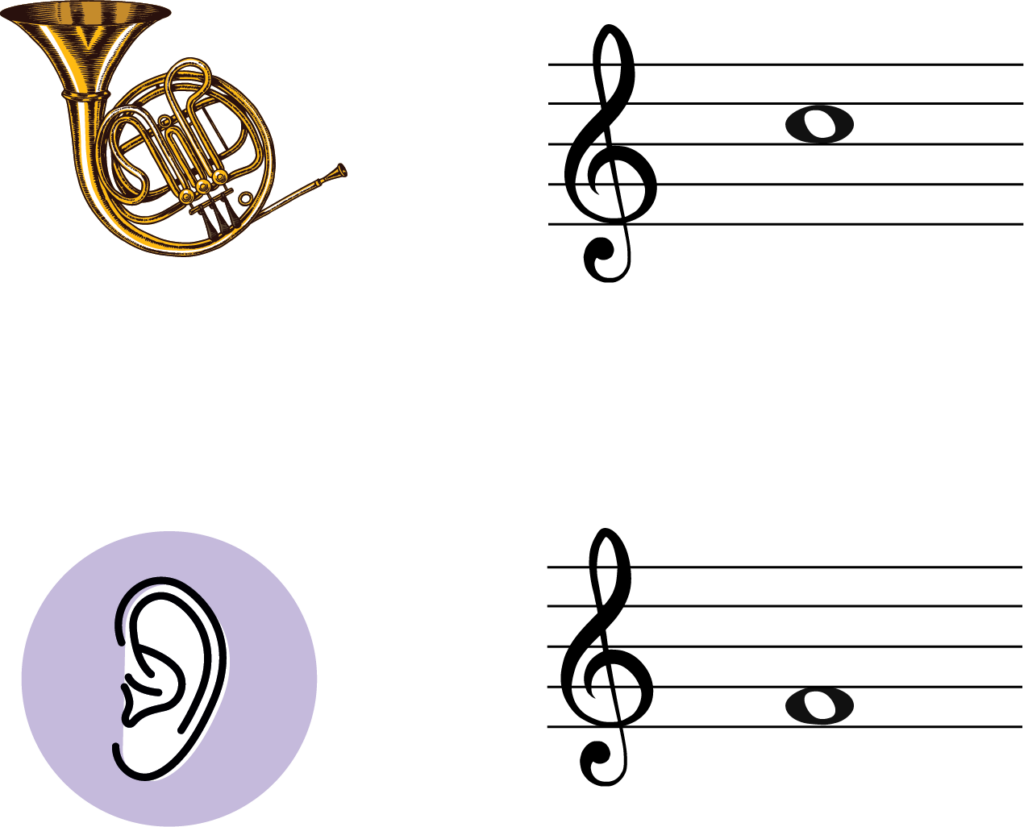
If you play the French Horn and you want to compose music that harmonises with the piano, your sheet music will be a perfect 5th above the notes in the piano’s sheet music (or any other non-transposing instrument). Or you may want to play a flute piece on your French Horn, so you will have to raise each note a perfect 5th (7 half-steps) to play it in the same key as the flute did.
Another use would be if you are a flute player and you want to play a piece written for the French Horn. To play in the same key as the French Horn you would need to lower the music 7 half-steps (a perfect 5th).
Transposition for French Horn to Concert Pitch
Concert pitch is the key non-transposing instruments play (the key of C). To move from the French Horn to concert pitch we are going to have to transpose between F and C, or by a perfect 5th.
Transposing from F to C involves up moving the notes up 7 half-steps (semitones) or 3 and a half whole steps (tones). This is the same as moving up an interval of a perfect 5th as C natural is the 5th note in the C major scale.
There are two different methods to transpose from F to C.
Method 1- Move notes up one at a time
Let’s kick off transposition for French horn with the melody below.

The melody is written in key of D major. We could move all the notes up three half steps (semitones), making sure that we take into account the F# and C# notes in the original key.
Here is the new melody. As you can see, we now have three sharps, so we are in the key of A Major.
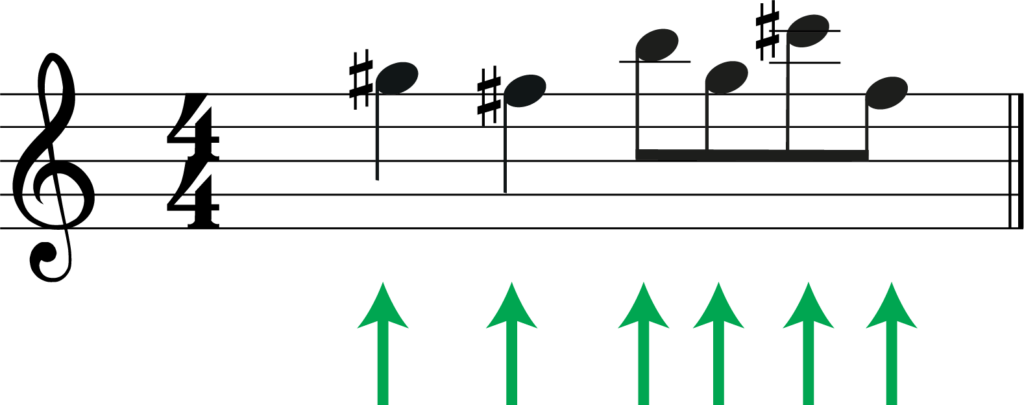
Here is the new melody with the correct key signature.

The problem with this method is that it can take a long time to move up each note as we have to transpose based on a different scale or count up in semitones. The new key signature can also be difficult to find as we might not see all the accidentals in our new melody. If we didn’t have a F#, C# and G# in the new melody, how would we know that we are in A major?
Method 2 – Transpose the key signature
Here is the 2nd (and preferred) method for transposition for French horn.
- We could move up all the notes up a fifth (or up four positions)
- Transpose the key signature up a perfect 5th
- Deal with any notes outside the original key
Look at the melody below.

It is in Eb major so we have Bb, Eb and Ab. First let’s move all the notes up a fifth. As we include the note we are starting on, this means moving the notes up four positions on the staff.

Now we can transpose our key signature. What is a perfect 5th above A flat? Another way to put this is by counting up 7 half-steps as this is the same as a perfect 5th. B flat is the perfect 5th above Eb because Bb is the 5th note of the E flat major scale.
Here is our transposed melody with the new key signature.

Below is the full transposition with the original and new melodies.
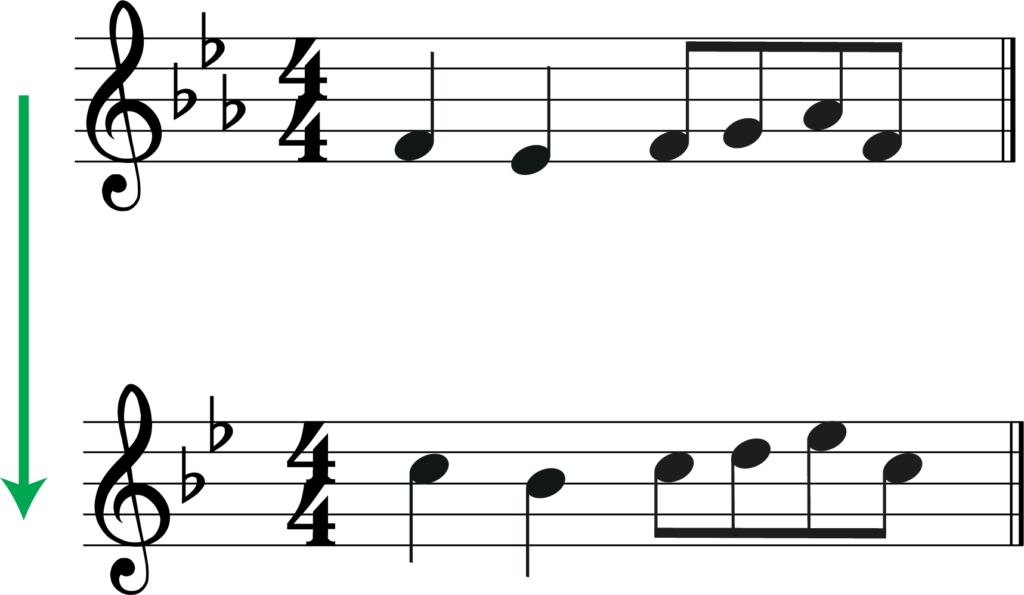
If there were any accidentals that were outside the key of Eb, we would not use this method. Instead we would treat them as individual notes and transpose them on their own. So if we had a C# then this would move up to a G# (7 half steps above).
Both these methods work when either transposing up or down a perfect 5th.
French Horn Transposition Chart
Here is a handy chart for helping you with transposition for French Horn. You can use it to transpose a single note, for example C to G, or you can use it to transpose the key signature of a piece. For example a piece in D Major would transpose up a perfect 5th to A Major.

Transpose French Horn to Piano
The piano is in concert pitch, or in the key of C. This means that transposing between the piano and French Horn involves moving up or down a perfect pitch (from F to C). For more on this see the example above on how to transpose to concert pitch.
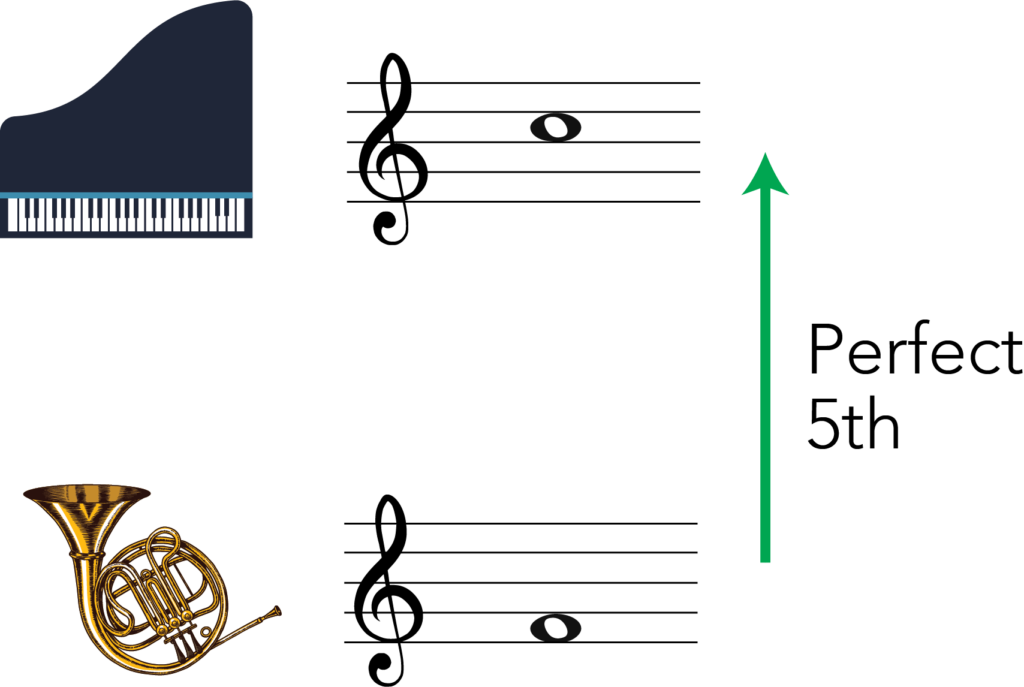
Transpose French Horn to Trumpet
The trumpet is a transposing instrument in the key of Bb. This means that it is a Major 2nd below concert pitch. The French Horn is also a transposing instrument in F (a Perfect 5th below concert pitch).
The interval of F to the B flat above is an Perfect 4th. Or we could say it is 5 half-steps (semitones).
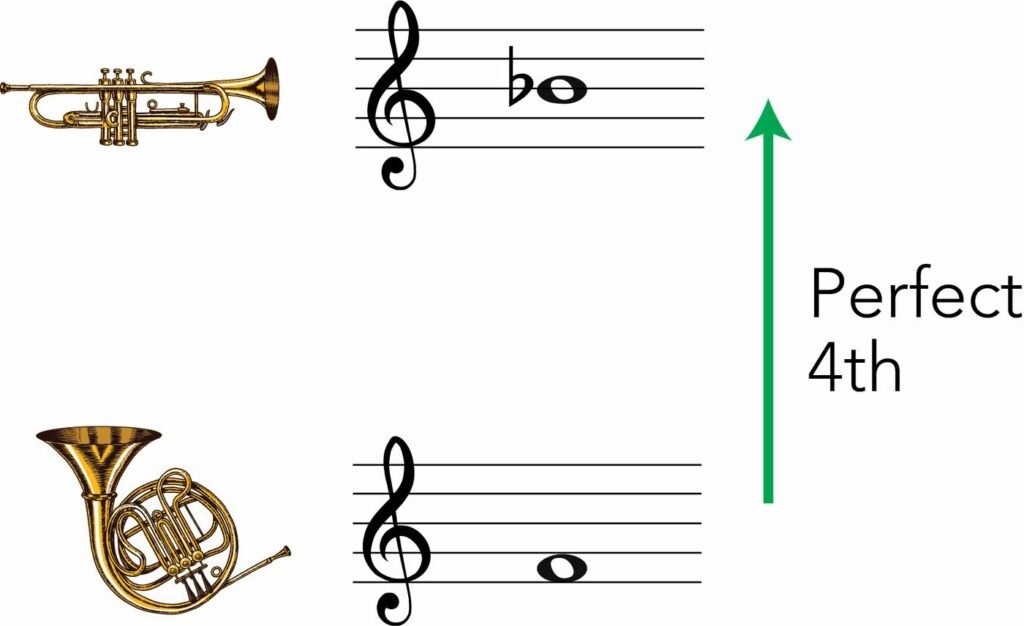
So why is this type of transposition useful? Well, we might want to play music written for French Horn on the trumpet, or we might want to write harmonising parts for both instruments. By transposing by a Perfect 4th we can do this.
Transposition for French Horn to trumpt:
- Transpose down a Perfect 4th (5 half-steps) to play French Horn music on the trumpet.
- Transpose up a Perfect 4th to play trumpet music on the French Horn.
- To have both instrument harmonising in the same key, we need the French Horn part to be 5 half-steps higher than the trumpet part.
What is a Perfect 4th and how do you use this interval? Check out our guide to transposing up by a Perfect 4th and transposing down by a perfect 4th.
Transpose French Horn to Tenor Sax
The French Horn is a transposing instrument in the key of F. This means that it is a perfect 5th below concert pitch. The tenor sax is a transposing instrument in Bb, so we have the interval of Bb – F between them.
Bb – F is a Perfect 5th interval as F natural is the 5th note in the B flat Major scale.

So why is this type of transposition useful? Well, we might want to play music written for the tenor sax on the French horn or we might want to write harmonising parts for both instruments. By transposing by a perfect 5th we can do this.
Transposition for French Horn to Tenor sax:
- Transpose up a perfect 5th to play French horn music on the tenor sax.
- Transpose down a perfect 5th to play tenor sax music on the French horn.
- To have both instrument harmonising in the same key, we need the French horn part to be a Perfect 5th below the tenor sax part.
Need step-by-step examples of transposing by a perfect 5th? Check out our guides: transpose up a perfect 5th and transpose down a perfect 5th.
Transpose French Horn to Eb Horn
The Eb Horn is (unsurprisingly!) a transposing instrument in the key of Eb. This means that it is a major 6th below concert pitch. The French horn is a transposing instrument in F, so we have the interval of Eb – F, which is a Major 2nd.
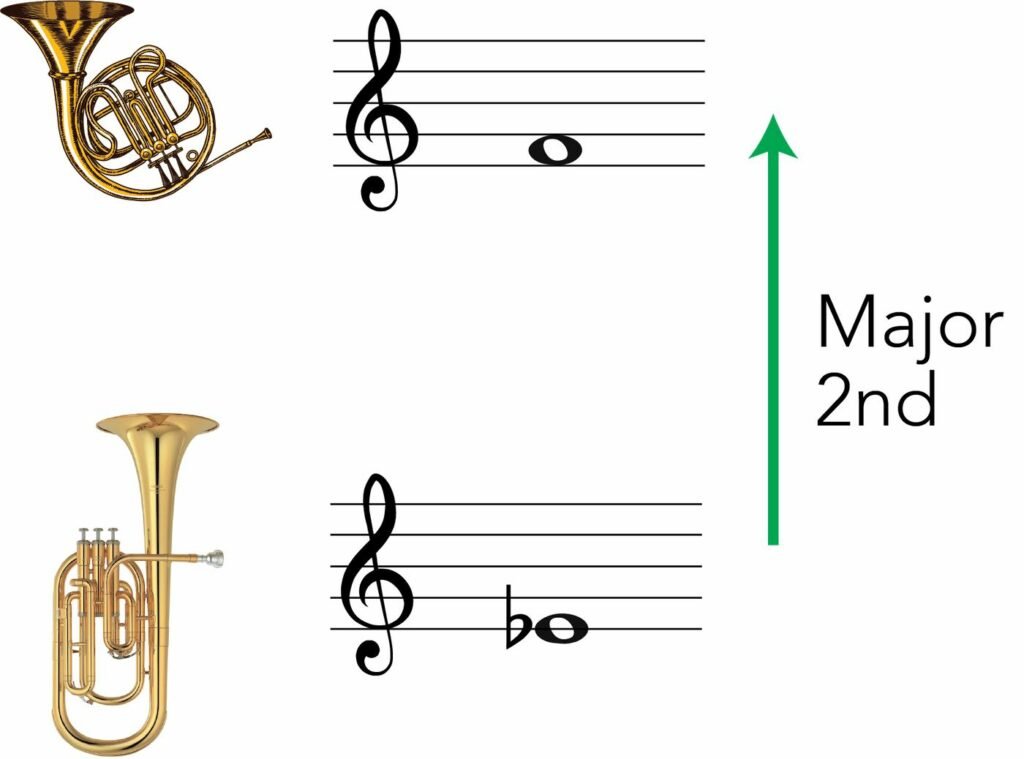
Transposition for French horn to Eb horn:
- Transpose up a Major 2nd to play French horn music on the Eb horn.
- Transpose down a Major 2nd to play Eb horn music on the French horn.
- To have both instrument harmonising in the same key, we need the French horn part to be a Major 2nd below the Eb horn part.
What is a Major 2nd and how do you use this interval? Check out our guide to transposing up by a Major 2nd and transposing down by a Major 2nd.
Transpose French Horn to Euphonium
The Euphonium is a transposing instrument in the key of Bb. This means that it is a major 2nd below concert pitch. The French horn is a transposing instrument in F, so we have the interval of F – Bb, which is a perfect 4th.
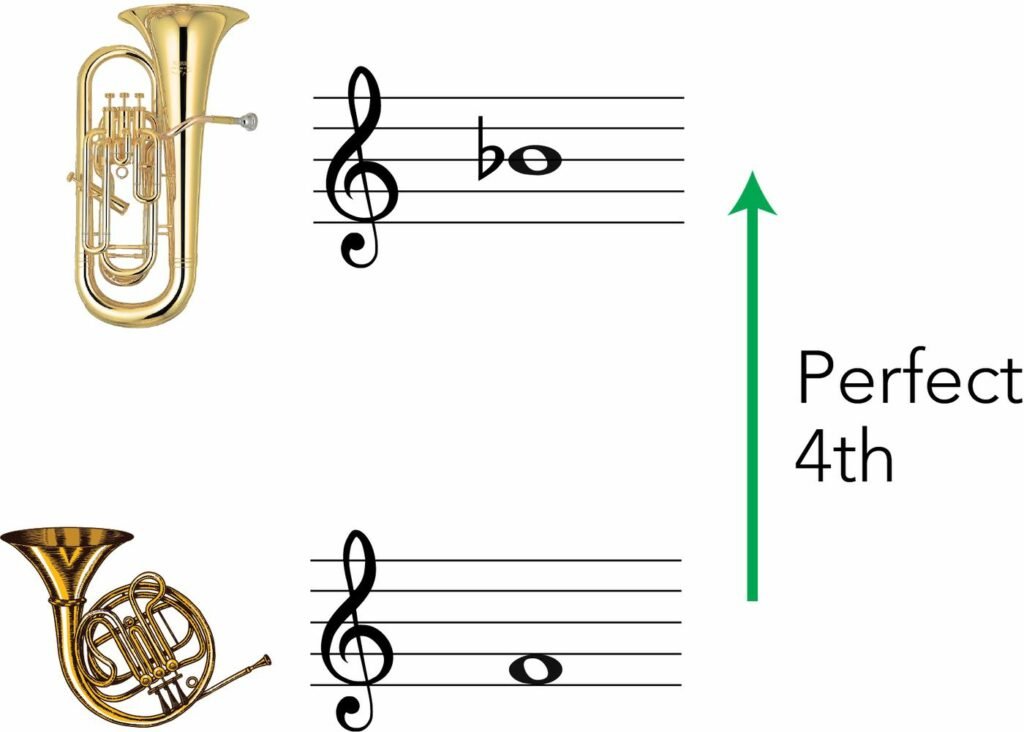
Transposition for French horn to Euphonium:
- Transpose down a Perfect 4th to play French horn music on the Euphonium.
- Transpose up a Perfect 4th to play Euphonium music on the French horn.
- To have both instrument harmonising in the same key, we need the French horn part to be a Perfect 4th above the Euphonium part.
What is a Perfect 4th and how do you use this interval? Check out our guide to transposing up by a Perfect 4th and transposing down by a perfect 4th
Using computer software
A far quicker method of transposition is to use software to do it for you! Apps like Musescore, Sibelius and Finale will transpose whole pieces with the press of a few buttons. You can then export, print and share your new transposed sheet music.
What’s next….?
- Learn more about intervals with our guide to augmented and diminished intervals.
- Check out our range of transposition guides.
